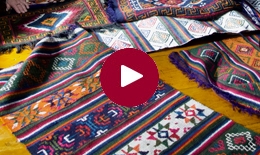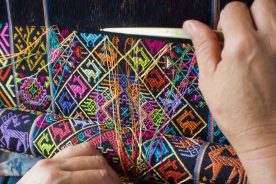
- Grade:
-
?
Gentle
Suitable for people who enjoy easy-paced walks or exploring the countryside on foot.
Find out more...
Gentle
-
?
- Duration: 21 days from the UK
- Walks on: 7 days
Land only from £6250
Visit the weavers of Bhutan in the company of renowned textile artist Sue Lawty on a fascinating journey across the kingdom.
Highlights
- Experience first-hand the unique textile traditions of Bhutan in the company of Sue Lawty, one of the foremost textile artists in Britain
- Meet local weavers and learn about the rich Bhutanese culture of spinning and weaving
- Visit small villages and stay in homestay accommodation to experience life with a Bhutanese family
- See the key cultural highlights and enjoy walks in the beautiful Bhutanese countryside
- Join the revelries at two colourful local festivals
Reviews
At the eastern end of the mighty Himalaya lies the tiny Buddhist kingdom of Bhutan. This traditional nation, without doubt, produces the finest woven fabrics to be found in the Himalayan region. Weaving is an ancient art in Bhutan and its textiles are an integral part of its culture and heritage and are unique for their diversity and sophistication. With skills handed down from generation to generation and from family to family, weaving in Bhutan is today an art form that is representative of the very heart of the country.
Sue Lawty led our first 'Weavers Trail' in 1995 crossing the country from west to east. Our latest itinerary traces a similar route, travelling through the cultural heartlands to the lesser-known east of the country. On the way, there are visits to, among others, the raw silk 'bura' weavers in the remote village of Radi, the K weavers of Lhuentse district and Khoma village and the ‘yathra ‘ weavers of Bumthang. In addition you will be introduced to other regional traditions of silk, cotton, wool, yak wool and nettle weaving and further crafts such as pottery and paper making, woodcarving and painting.
This unique trip has been designed to combine first hand experiences of weaving, visits to weavers in their own homes and to the important textiles centres of the kingdom. You will have opportunity to see all the processes involved in producing textiles, dyeing, spinning and weaving as well as the different uses for these textiles, such as in day to day wear of Bhutanese men and women and the rich textiles used for festival attire and religious costumes. This in-depth, specialist tour weaves together a colourful tapestry of textiles, history, rich cultural heritage and stunning landscapes. In addition you will visit some of the most iconic temples, monasteries and dzongs of the kingdom including beautiful Punakha Dzong and iconic Taktsang Monastery and you will have the opportunity to take some lovely walks through picturesque countryside and to more isolated villages. An additional attraction is the opportunity to stay with local families in Khoma Village and Ura where you will learn about day-to-day life in rural Bhutan. You will also enjoy a day at a colourful festival - a real highlight of any trip to the Thunder Dragon Kingdom.
At a glance
Gentle
Duration: 21 days from the UK
Walks on: 7 days
Max. Altitude: 3,750m/12,303ft, Thrumshing La, Day 12
Guaranteed to run for a minimum of 4 clients
Maximum group size: 12
Accommodation types: Hotels, Homestays
Festival:
Attends the Punakha Tsechu & Tangsibi Mani Tsechu
Meal arrangements: 19 x breakfasts, 17 x lunches, 17 x dinners.
Itinerary overview
| Day | Activity |
|---|---|
| 1-3 | Fly to Delhi. Sightseeing. Fly to Paro in Bhutan. Sightseeing in and around Paro. |
| 4 | Walk to visit Taktsang Monastery. |
| 5 | Drive to Thimphu. Visit the Textile Museum, paper factory and Weekend Market. |
| 6 | Visit giant Buddha statue above Thimphu. Drive to Punakha. Walk to Chimi Lhakhang and visit Punakha Dzong. |
| 7 | Drive to Gangtey. Walk and visit Black-necked Crane Museum and short walk. |
| 8 | Drive to Jakar with visits to Chandibji Chorten, Trongsa Dzong and weaving workshop en route. |
| 9 | Attend Jambay Lhakhang Drup festival. |
| 10 | Walk in Jakar area. Visit weaving centre and Wangduechhoeling Palace. |
| 11-12 | Drive to near Ura and walk to village. Overnight in homestay. Drive to Autsho. |
| 13-15 | Drive to Khoma weaving village. Observe pottery and weaving demonstrations. Walks and sightseeing around Khoma. Stay in homestay. |
| 16-17 | Drive to Mongar via Tangmachu and Khaine Lakhang. Continue to Trashigang and visit dzong. |
| 18 | Village walk. Visit Radi weaving village. |
| 19 | Drive to Samdrup Jongkhar. |
| 20-21 | Cross border into India and drive to Guwahati. Fly to Delhi. Overnight Delhi. Fly to UK. |
Leader: Sue Lawty - Artist
Sue is one of Britain’s finest artists. Alongside other mediums, Sue has worked with textiles all her life and has exhibited extensively across the world. She is a tutor and visiting lecturer and has travelled on ‘weaving journeys’ to Bhutan, Morocco, America, Australia, India, Nepal and Poland
Sue held a year long Residency at the V&A in London and has been awarded prestigious Artist Research Fellowships at both the Smithsonian National Museum of Natural History, Washington DC and the Faculty of the Environment, University of Leeds. She was recently invited to take up a significant three month international artist residency in Stockholm.
Sue is an accomplished fell runner and mountain trekker and has led many successful trips for Mountain Kingdoms since she led our first Weavers’ Trail in Bhutan in 1995, later also leading treks to Dolpo and Zanskar. More recently, in 2019, she returned to Bhutan to lead our specialist Weavers’ Trail walking holiday and in 2022 and 2023 led the first departures of Colours of India.

Holiday Itinerary
Day 1 - Fly London to Delhi
Fly overnight from London to Delhi.

Day 2 - Arrive Delhi. Group transfer to hotel. Visit Delhi Crafts Museum.
On arrival in Delhi you will be transferred to your hotel located close to Delhi airport.
In the afternoon, if your flight schedule allows, you will have a trip to the Delhi Crafts Museum where artisans demonstrate traditional embroidery, weaving, carving and pottery making - a fantastic place to get an introduction to the textiles of India.

Day 3 - Fly to Paro. Sightseeing in the Paro Valley including the National Museum and Samden Weaving Unit.
After breakfast you will transfer to the airport for your flight to Paro in Bhutan. You will meet your guide on arrival and head off for some sightseeing in Paro and its surrounding valley. The beautiful Paro Valley has always had a great strategic importance for Bhutan and was historically an important staging post on the trade routes with Tibet. The spectacular Paro Dzong, situated on a rocky outcrop above the Paro Chu and with views down both sides of the valley was historically one of Bhutan's strongest and most strategic fortresses. Before the rebuilding of the Tashichhodzong in Thimphu, it was also the seat of Bhutan's National Assembly.
You may begin your time in Paro with a visit the ancient and beautiful temple of Kyichu Lakhang which was one of 108 temples built by Songtsen Gampo, an important early Tibetan king, to pin down the Bon demon who was thought to hover over the whole of Tibet.
You will also visit the impressive Paro Dzong, one of the most important in the kingdom. Above the dzong is the ancient watchtower or Ta Dzong which houses the Bhutan National Museum and has a fantastic collection of Bhutanese treasures with displays including depictions of some of the wide range of Bhutan's history and culture and an impressive collection of ancient thangkas featuring Bhutan's important saints and teachers. You will also find some fearsome festival masks, a collection of religious statues, some early stone carvings and the original 14th century iron links from the nearby Tamchhog Bridge.
Later you will drop into the Samden Weaving Unit which houses a small weaving unit and a handicraft shop. The owner, Mrs Choki, happens to be the mother of a famous Bhutanese actress, Tandin Bidha.
For the remainder of the day you can explore Paro town.

Day 4 - Walk to Taktsang Monastery – the Tiger’s Nest. Time at leisure.
A short drive beyond Paro town takes you to the trail head for the walk up to the famous Tiger's Nest, Taktsang Monastery. The monastery is perched some 600m/2,000ft up on a cliff overlooking the valley and was said to be where the legendary Indian saint, Guru Padma Sambhava, flew from Tibet on the back of a tiger to defeat five demons, who were opposing the spread of Buddhism in Bhutan. It's a steep, uphill walk through woods of about 1½-2 hours, to reach a tea house (an ascent of 340m/1,115ft). Apart from offering welcome refreshment this tea house is one of the principle viewpoints of Taktsang, and those who prefer not to climb any further can relax here whilst others continue on. If there is a particular religious gathering or VIP visit in progress, you will not be able to enter the monastery but the further half an hour's ascent is well worth it in any case, as it brings you to another viewpoint directly across from Taktsang. If you are able to make a visit, the final section of the walk takes you from here steeply down 100m/330ft into the gorge that separates you from the monastery and then climbs back up again to reach the monastery gate.
The rest of the day is free for you to rest at your hotel or do a little exploration on your own.

Day 5 - Drive to Thimphu – 1-1½ hours. Visit the Textile Museum, the paper factory and the Weekend Market.
This morning you will drive to Thimphu. En route you will stop to visit Tamchhog Lhakang. This temple was built in the 14th century by the son of the very famous 'Iron Bridge' builder, Thangthong Gyalpo. You cross one of the eight bridges he built in Bhutan to reach the temple. It is an easy 15 minute walk from the road and has the immediate effect of transporting you back into the atmosphere of ancient Bhutan. Driving on to Thimphu you will see that it has an attractive valley location and is relatively small for a capital city, although it has grown greatly in recent years.
First stop in town is the Textile Museum, which gives a good overview of Bhutan's textiles and weaving methods which differ quite substantially from region to region. Exhibits introduce the major weaving techniques, styles of local dress and textiles made by both women and men. Then you will see a traditional Bhutanese craft with a visit to the handmade paper workshop to observe the processes involved in making paper. The paper made here is based on materials unique to the Himalaya, the bark of the Daphne Papyri, which is found at altitudes of 3,000 feet and above, the bark of the Edgeworthia Papyri and various additional ingredients like flowers and leaves which add textures and patterns. There are some nice items made from handmade paper for sale here.
Your last stop is at the Weekend Market where you will find numerous stalls crammed along both banks of the Wang Chhu. Stallholders arrive from throughout the region on Thursday and Friday and remain until Sunday night. On one side are mainly food stalls including pungent spices, strings of datse (cheese), meats, nuts, tea, fruits, grains. On the other bank are handicrafts so you may be able to pick up an early souvenir.

Day 6 - Visit giant Buddha statue. Drive to Punakha – 3 hours via the Dochu La Pass. Visit Chimi Lhakhang and Punakha Dzong.
Before leaving Thimphu you will drive up to see the giant Buddha statue,which you will have seen from below, perched high above the town. It is a very impressive sight close-up and there are far-reaching views across Thimphu from its lofty position.
Driving out of Thimphu you climb to cross the Dochu La Pass, 3,048m/10,000ft, a spot marked by 108 chortens. Here, weather permitting, you may take in a magnificent mountain vista. On clear days there are fabulous views of the eastern Himalaya from here, but this is a beautiful spot even on misty days. You then drive down through varied forest into the lush Punakha Valley.
You will have chance to stretch your legs when you arrive in the valley with a short walk to Chimi Lhakhang. This ancient temple was one of 108 temples built by an important early Tibetan king, Songsten, Gampo, in an attempt to pin down the Bon demon who was thought to hover over the whole of Tibet. Returning to your vehicle, you then drive into Punakha town to visit its famously picturesque dzong, situated at the confluence of two rivers. In 1994 there was a major flood in the town which caused a lot of damage to the dzong, but it has now been beautifully renovated and is a real showcase for Bhutanese craftsmanship and painting.

Day 7 - Drive to Gangtey – 3-3½ hours. Walk in the valley. Visit Gangtey Dzong and the Black-necked Crane Information Centre.
After breakfast you make the journey to Gangtey. Leaving Punakha you drive down the valley to the town of Wangdiphodrang whose massive and important dzong unfortunately burnt down in 2012 and is now under reconstruction. You drive through the few houses which mark the former township of Wangdi and then drive up the beautiful, wooded valley of the Dang Chu into Gangtey.
Gangtey, also known as Phobjikha, is a beautiful glacial valley, wide, wooded and unspoilt. It is particularly famous as a major wintering ground for Black-necked Cranes, which arrive here late October and stay until early spring before heading back to their breeding grounds in Siberia.
In addition to its natural wonders, the valley boasts some intriguing myths and legends surrounding local events and places, including tales about two different types of yeti, a large one and a small variety, as well as many other interesting tales. A number of different walks are possible here and your guide will suggest a suitable one for your group.
After your walk you will visit Gangtey Dzong and then on to the Black-necked crane Information Centre. The centre has many interesting displays about the cranes and their cultural and religious significance to the local people. Finally, you will enjoy another walk in the village near your hotel.

Day 8 - Drive to Jakar across the Pele La - 5 hours. Stop at Chandibji Chorten, Trongsa Dzong and a weaving workshop in Zugney on the way.
Today you make the drive from Gangtey to Jakar. It's a long drive but full of scenic and cultural interest with several opportunities to stop and enjoy the sights. First comes the Pele La Pass, 3,300m/10,825ft, where you will hopefully have some fine mountain views. Next stop is Chandibji Chorten which you'll see is decorated in a similar manner to Swayambanuth Temple in Kathmandu although on a much smaller scale.
Continuing on the road east, you will see Trongsa's splendid Dzong long before you reach it because the road takes you up a long side valley before eventually turning back towards Trongsa. The ancestral home of Bhutan's royal family, Trongsa is an exceptionally dramatic dzong set high above the roaring Mangde Chhu. Its strategic location meant that it was also one of the most important dzongs in the country. After a short visit you carry on, past Trongsa and across the Yotong La, to reach the village of Zugney. The village is a famous centre for weaving and you will attend a workshop to see the industry that is an integral part of Bhutanese society. It is said that every home here is equipped with a loom for weaving and young girls are proficient in the craft before they reach the age of twenty.
From Zugney you finish the drive to Jakar, in the cultural heartland of Bhutan.

Day 9 - Attend the Jambay Lhakhang Drup Festival.
Today will be one of the highlights of your stay in Bhutan as you will attend the Jambay Lhakhang Drup Tsechu.
The festival takes place at Jambay Lhakhang which is one of the country's oldest temples, built in the mid-7th century. One interesting feature to look for is the set of three steps in the main temple. The first step, now hidden below floor level, is said to represent the time of the past or 'historical' Buddha. The second, very well worn, step represents the present Buddha, whilst the third step above, is said to represent the age of the future Buddha. The point at which the second step is worn down to ground level is held to be the time when the world as we currently know it will end.
Bhutanese festivals are great opportunities for the Bhutanese to get together not only to socialise and have fun but also because the very act of attending a festival is thought to confer merit. Village people from the area gather to participate in the festival, singing and dancing. The three-day Jambay Lhakhang Drupchhen is one of the most ancient and sacred festivals in Bhutan - it is supervised by Chakar Lama (Descendant of King Sindhu Raja who invited Guru Rinpoche to Bumthang from India). There are different categories of dances, those that are intended to give moral instruction, those designed to drive away evil spirits and those that celebrate the Buddhist faith in its many guises. There is even a midnight dance through the fire! Whichever day you are attending it will be an unforgettable experience, unique to Bhutan.

Day 10 - Morning ‘temple walk’ in the valley. Visits to Dorjibi Weaving Centre and Wangduechhoeling Palace.
There are several temples in the Jakar valley which you will explore on a gentle walk. Nearest to your hotel is the Jambay Lhakhang, one of the country's oldest temples, built in the mid-7th century. Look out for the set of three steps in the main temple. The first step, now hidden below floor level, is said to represent the time of the past or 'historical' Buddha, the second, very well worn, step represents the present Buddha, whilst the third step above, is said to represent the age of the future Buddha. The point at which the second step is worn down to ground level is held to be the time when the world as we currently know it will end. From Jambay Lhakhang you may walk along a farm track for 30 minutes to reach Kurjey Lhakhang, a series of three large temples. The oldest of the temples here houses a rock indented with the body shape of Guru Rinpoche, whilst the most recent dates back just 30 years and was built by the Queen Mother, Ashi Kesang Wangchuck.
Once your walk is finished you will head off to the Dorjibi Weaving Centre near Bumthang. The centre was created to empower local women from the nearby villages in particular Dawathang, Pangrey and Dorjibi. In doing so they hope to create self sufficiency and an income for their families, where agriculture could not. It's also a means to help keep the tradition of weaving alive. They mostly weave Yathra (woolen fabrics) on Bhutanese looms producing jackets, bedding and other items.
You finish the day with a visit to the oldest palace in Bhutan - Wanduechhoeling. It was built in 1857 as the principal residence of the first king of Bhutan, Ugyen Wangchuck and has recently been restored and converted into a museum. The museum houses numerous treasures including rare manuscripts and a sacred shrine.

Day 11 - Drive to Ura. Walk down from the pass to Ura Village - 1.5 hours.
This morning you will drive out of Jakar Valley for 2-3 hours until you eventually reach a high pass above the village of Ura. This is the Ura La (also called the Shertung La) at 3,573m/11,722ft. From here, on a clear day, there are fantastic views of Bhutan's highest mountain, Gangkar Punsum, 7,550m/24,770ft.
You leave your vehicle at the pass and walk down to Ura Village, a pleasant walk through a lovely forest. When you arrive in the extremely picturesque village, you will visit the small village gompa, dedicated to Guru Rimpoche, and will then stroll through the medieval looking streets to reach the Bangpa Heritage Farmstay, a large traditional farmhouse offering comfortable if simple accommodation.

Day 12 - Drive to Autsho across the Thrumshing La Pass, 3,750m/12,303ft – 7-8 hours.
Today you drive to Autsho. This is a long but stunning drive of many startling contrasts, crossing one of the highest road passes in Bhutan and passing through alpine scenery and sub-tropical forest and travelling one of the most dramatic and spectacular roads in the kingdom. Leaving Ura to rejoin the main highway, you enter the alpine landscapes of the Thrumshing La National Park, passing beneath overhanging cliffs to reach the Thrumshing La Pass, 3,750m/12,303ft, in about one hour. This is the highest point of your trip and, on a clear day, you may be able to see Bhutan's highest peak, Gangkar Punsum. From the pass the road starts its descent, in places hacked into the cliffs, with numerous streams and waterfalls crashing down. Leaving the national park the road emerges into the upper part of the Yong Khola into dense forest, where the scenery becomes lush and sub-tropical with huge trees, bamboos and ferns. This wilderness is one of the prime birdwatching areas in Bhutan. From the forest the road continues to descend through cultivated terraces to arrive at Kuri Zampa bridge, the lowest point of the drive at 570m/1,970ft, an astonishing descent of 3,200m/10,500ft from the pass. From the bridge, the road climbs up for a further hour through pine forests and cultivated fields to reach Mongar and it is then another hour or so north to reach Autsho.

Day 13 - Visit Namdroling Goenzin Dratshang Monastery. Drive to homestay at Khoma weaving village. Short hike to Sangwai Dadrung.
You begin the day with a visit to Namdroling Goenzin Dratshang Monastery in Autsho. The monastery was built in 2006 under the supervision of Yab Rigzin Dorje. It is home to over one hundred monks who study and take part in frequent ritual ceremonies,
From the monastery you drive on to Khoma village where you will be spending the next three nights in Khoma village is famous for its intricate woven cloth called kishuthara and is said to be the birthplace of Bhutan's traditional weaving culture. The weavers here produce some of Bhutan's most sought after and expensive kishuthara textiles. Women throughout the kingdom wear kishuthara on special occasions such as wedding and at festivals.
Having arrived at the homestay, and no doubt been given tea and other refreshments, you will finish the day with a short hike to Sangwai Dadrung. This sacred site is a cave beneath a large rock entrance and your guide will no doubt tell you all about the legend surrounding it.

Day 14 - Short drive to Gonpa Karpo. Observe pottery and nettle weaving demonstrations. Walk back to Khoma.
After breakfast you make the short drive to Gonpa Kharpo Lhakhang, located on a ridge overlooking Lhuntse, and the centre of another area famous for its weaving. Whilst in the area this morning you will see some of the local weavers at work, as well as pottery being made and cloth woven from nettles.
Later you will walk back to Khoma and spend some time looking around the village.

Day 15 - Drive to visit Lhuentse Dzong and town including a pottery. Time at leisure.
Just a few miles southwest of Khoma is Lhuentse best known for its spectacular dzong. It sits fair and square on top of a steep hill, rising from the valley floor and commanding an impregnable position. It is the ancestral home of the kings of Bhutan and was originally established by Pema Lingpa's son, Kuenga Wanpo in 1543. The present Royal family trace their lineage directly to the important saint of Pema Lingpa.
A small township straggles the mountainside below the dzong and here you will visit a pottery before returning to Khoma. The rest of the day is at leisure.

Day 16 - Drive to Tangmachu village to see Guru Rinpoche statue. Continue to Khaine Lhakhang and visit temple. Drive to Mongar
You say farewell to your hosts after breakfast and drive to Tangchmachu. This is a small village and really quite remote, but is nevertheless the site of the largest statue of Guru Rinpoche (height: 173ft). The statue was constructed by men instead of machines at the instigation of the venerable Khenpo Karpo Rinpoche. Its purpose is to bring peace and prosperity to the world and for the benefit of all sentient beings.
Having admired the statue you continue up a zig-zagging road to Khaine Lhkhang. This is an incredibly important small temple, one of 108 built by King Songtsen Gampo in AD 659. It is said that three statues flew from here of their own accord to a temple in one of the main valleys of Bumthang. You can park at one end of the village and walk along the road to the temple.
From the lhakhang you return to your vehicle and drive to the town of Mongar where you spend the night.

Day 17 - Drive to Trashigang with walks en route. Explore Trashigang.
You travel further east today as you leave Mongar and drive to the town of Trashigang. En route, there are a couple of options for walks through the picturesque countryside.
Once you arrive in Trashigang you will have time to explore with your guide. The town is the largest in eastern Bhutan and is quite attractive with its pretty painted houses and colourful bougainvillea and geraniums. The town is clustered round a small central plaza with a large prayer wheel, a bank, some shops, bars and cafes. You may find ad-hoc market stalls set up in the town as it is the main marketplace for the people of the area. Below the plaza is the spectacular Trashigang Dzong, set on a spur high above the valley. This dzong was built in the 17th century to guard against Tibetan invaders and was one of the most strategically important in the country. It is now the administrative seat for the district as well as a religious centre.

Day 18 - Village walk. Drive to Radi via Rangjung. Visit weavers in their homes at Radi.
Your day begins with a gentle walk from Trashigang to the village of Khapti. First you will drive to the High Court, a handsome building set a little above the town, and from near here take a rocky trail which leads up above the town and then through lovely forest with lots of birds and wildlife. The trail continues through a couple of pretty small villages before coming out on to a feeder road where you will meet your transport. This will be a pleasant and undemanding walk.
A little further along the road, you will stop at Rangjung, a prominent religious centre in the east with several Buddhist monasteries. You will briefly visit the large Nyingmapa Gompa at Ranjung, which has a school for monks attached to it.
From Rangjung it is just a few more miles to reach Radi. Sometimes called 'the rice bowl of the east' you will notice the many verdant terraced rice fields that supply much of the grain to the eastern part of Bhutan. Along with its rice production, the villages around this area are famous for their weaving which is the main activity and source of income in the non-agricultural season. In Radi you will visit weavers and village homes to see the raw silk textile weaving known as 'Bura'.
At the end of the day you will make the return journey to your hotel in Trashigang.
Day 19 - Drive to Samdrup Jongkhar – 7-8 hours.
It is a long drive to Samdrup Jongkhar but it's a very scenic journey. After eaving Trashigang, you pass through Sherubtse and the campus of the country's premier University College before you climb to the Yongphu La Pass, 2,190m/7,185ft, offering a final glimpse of the Himalaya. Continuing, down from the pass you next reach Khaling, where one of the most famous weaving centres in Bhutan is located, providing cloth for the royal family.
It is a further four to five hours drive from here to Samdrup Jongkhar across the Kharung La at 2,350m/7,710ft - the highest point left on your trip. As you get closer to the border, you will enjoy wonderful views of forested hills and valleys rolling away to the foothills and the Indian plains of Assam State. You can often see Langur monkeys, kingfishers, eagles and other brightly coloured birds along the roadside. The Indian-like border town of Samdrup Jongkhar is literally at the very foot of the Bhutanese foothills and is quite subtropical.
Remember to keep your passport on you today as you may need to show it as you enter the town of Samdrup Jongkhar.

Day 20 - Drive to Guwahati – 3 hours. Fly to Delhi and transfer to hotel.
You cross the Indian border this morning and then drive to reach the airport at Guwahati to catch your flight to Delhi. On arrival you will be met and transferred to your hotel.

Day 21 - Group transfer to airport. Fly to London.
After breakfast you will be transferred to the airport for your flight home.
Loading...
Hold your place
Not quite ready to book? Why not call us on +44 (0) 1453 844400 to hold a no obligation place while you make up your mind?
Optional supplements
-
Single Room Supplement
From £595
No Surcharge Guarantee
No surcharges will be applied to your holiday after you book. Prices on this website are updated regularly. The Flight Inclusive holiday price, or Land Only holiday price, will be confirmed to you at the time you make your booking. There will be no surcharges after your booking has been confirmed.
Flight inclusive holidays
The 'flight inclusive' holiday prices shown on this website are based upon our preferred airlines and the best priced economy class fares we are able to secure at the time of publication.
We will be able to advise on fares with alternative airlines, upgrades to Business Class, and the options for flights from regional UK airports, please contact us for more details.
Booking your holiday
-
Deposit
From £400.00
For the majority of our holidays, a deposit payment of £400.00 per person is required to secure your place(s), however a small number of holidays require a higher deposit - please refer to the holiday itinerary for more details. If the holiday departs within 60 days, a deposit of £1,000.00 per person is required.
Book now!
- Book your small group holiday securely online – click the ‘Book’ button next to your chosen departure or visit our How to Book page
- Complete and return a Booking Form available to download here.
- Call us on +44 (0)1453 844400 and one of our travel specialists will talk you through the booking process.
What’s included
- 19 x breakfasts, 17 x lunches, 17 x dinners
- In Bhutan, good standard hotel accommodation in main towns and best available hotels in outlying towns, on twin-share, full board basis
- Good standard hotel accommodation in Delhi on a twin-share, breakfast only basis
- The services of Sue Lawty as trip leader
- Local Bhutanese English-speaking guide and driver to accompany group throughout.
- Bhutan visa and Bhutan departure tax
- All road transport by private vehicle
- Economy class return air fares from the UK and UK departure tax (flight inclusive only)
- Single, timed, group airport transfers for international flights on arrival and departure
- A free Mountain Kingdoms Water-to-Go bottle
- Carbon offsetting with the Ecoan Tree Planting Project (for clients taking our flight inclusive option)
What’s not included
- Travel insurance
- India visa fees
- Lunch and dinner in Delhi
- Tips
Extend your holiday
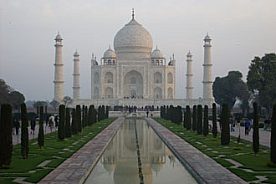
- 1-day and 6-day extension options available
- Add at the beginning or end of your holiday in India
- Sights include the Red Fort, Taj Mahal, City Palace and Amber Fort
After your adventures in India why not add an exciting day trip to Agra to see the sights of the one time capital of the great Mughal empire? Or, if you have more time available, perhaps a longer trip visiting both Agra and another gem of the ‘Golden Triangle’, Jaipur. Whichever option you take, once in Agra you will be looked after by one of our fully trained, English-speaking guides who will show you around the Red Fort, the Taj Mahal and the ancient city and mosque of Fatehpur Sikri. For those travelling on to Jaipur, you will take guided visits to the Amber Fort, Palace of the Winds and City Palace, along with time to explore the colourful bazaars of the ‘Pink City’.
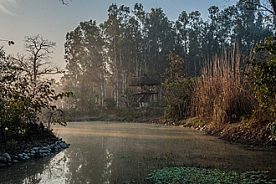
- Corbett National Park is home to one of the largest Royal Bengal Tiger populations in India.
- Over 50 species of mammals, many reptiles and hundreds of bird species to look out for.
- Ideal extension from Delhi to explore some of India's most fascinating wildlife.
Corbett National Park is the oldest national park in India. Located between the Himalayan foothills to the north and the ancient Shivalik Hills to the south, the reserve covers a wide range of habitat with dense woodlands, open grasslands, riverine vegetation, dry riverbeds and more hilly terrain and so offers much diversity. This varied habitat hosts a spectacular diversity of mammal, bird and reptilian life, unmatched anywhere in India.
The park is home to one of the largest Royal Bengal Tiger populations in India as well as other large cats such as leopard. There are also around 50 species of mammals including large herds of elephant and four species of deer. In the park you also find many reptiles, including the rare and highly endangered Gharial crocodile. Corbett has a spectacular bird diversity – there are several hundred resident species of bird with as many more crossing on their migratory routes with bird diversity being at its peak during the winter months.
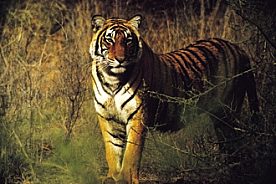
- Known for its population of tigers.
- Home to fascinating wildlife including jungle cats, hyenas, jackals, bears, crocodiles and large populations of langur monkeys.
- Enjoy safari drives as you look out for wildlife amongst the picturesque grassland, hills and lakes.
Ranthambore National Park in Rajasthan is one of the finest national parks in northern India. Formerly a hunting reserve for the Maharajas of Jaipur, you can see a huge variety of fantastic wildlife and birds in Ranthambore, but the park is particularly famous for its population of tigers - although of course sightings of tiger can never be guaranteed many visitors to this park are lucky enough to get good views. The scenery of the park is very varied with grassland, hills and lakes and there are also some very picturesque and atmospheric ruins located in the park. Even if you don’t see tigers there is abundant wildlife on view in Ranthambore with leopard and other cats such as jungle cats, caracal, hyena, jackal, wild boar, bear, several species of deer, and large populations of langur monkeys. Marsh crocodiles and other reptiles are also found in the lakes within the park. Owing to the wide range of habitats within the park there is also a large variety of fantastic and colourful birds, both resident and migrant, to be seen - in total, 272 bird species have been documented within the park.












